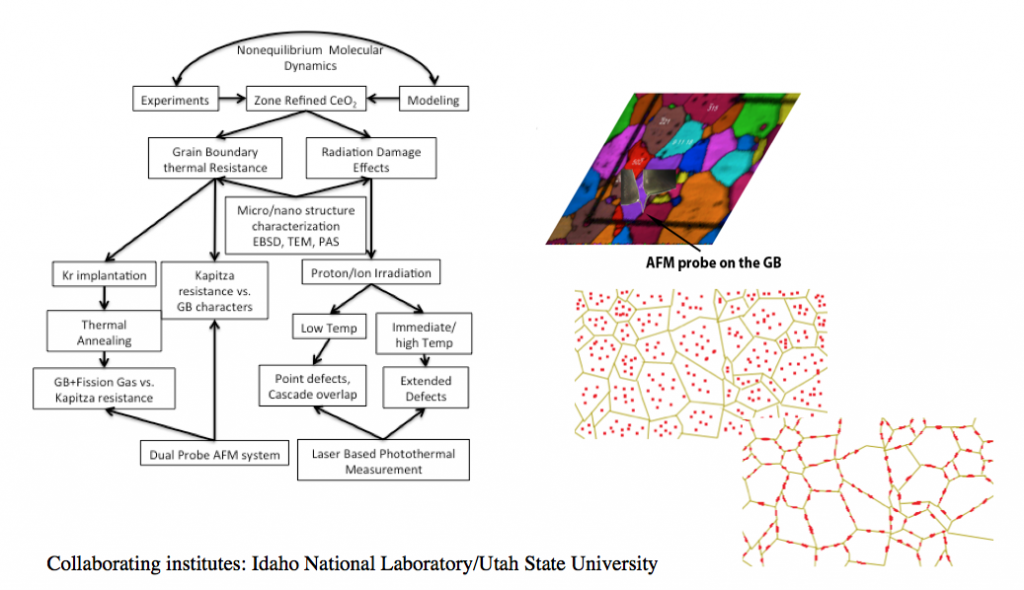“Innovative Coating of Nanostructured Vanadium Carbide on the F/M Cladding Tube Inner Surface for Mitigating the Fuel Cladding Chemical Interactions” (DOE-NEUP)
To conduct applied and fundamental research towards the development of diffusion barrier coatings on the inner surface of ferritic/martensitic fuel cladding tubes such as T91, HT-9 and NF616. An innovative coating setup will be built to deposit a uniform nanostructured vanadium carbide layer (less than 10μm in thickness and nano-sized grain structure) on the inner surface of long F/M cladding tube. The functionality of the coating as FCCI barrier will be examined experimentally using diffusion couple tests (cerium and uranium). Atomistic modeling will help understand the fundamental mechanisms of fuel cladding chemical interactions.
“Developing Microstructure-Property Correlation in Reactor Materials using in situ High-Energy X-rays” (DOE-NEET, through the Argonne National Laboratory)
Through collaboration with researchers at Argonne National Laboratory and Oak Ridge National Laboratory, the project is aimed to gain a fundamental understanding of deformation and fracture mechanisms on the microstructural level in reactor materials by using in situ high energy X-ray capability uniquely developed for characterization of neutron-irradiated materials under thermal-mechanical loading. The in situ high-energy X-ray probes for irradiated materials allow simultaneous characterization of microstructure and mechanical properties of an irradiated specimen using a combination of wide-angle X-ray scattering (WAXS), small-angle X-ray scattering (SAXS), three-dimensional X-ray tomography, and imaging.
“Engineered Zircaloy Cladding and Fuel Pellet Modification” (DOE/NE IRP through the University of Illinois)
The project is aimed to fabricate and evaluate modified Zircaloy LWR cladding for under normal BWR/PWR operation and off-normal events. This collaborative project lead by University of Illinois involves six institutes including UF. The main research task of my group is to characterize the corrosion kinetics of those modified Zircaloy alloys, and the results will be further fed back into the thermodynamic modeling and neutronic/thermal hydraulic calculations.
“Aging of Used Nuclear Fuel in Storage” (DOE/NE IRP through Texas A&M University)
This is an applied engineering project with a specific application in view (i.e. UNF dry storage). The project is aimed to characterize and model key limiting phenomena related to the performance of used nuclear fuel storage system. The project is lead by Texas A&M University along with five other research universities. Our research is mainly focused on low temperature creep behavior and delayed hydride cracking. A new white paper proposal based on this project’s finding was already submitted to DOE-NE, and it is expected to continue this project for another period of 3 years after the completion of the current one.
“Microstructural Analysis of Stainless Steels and Nickel Alloy” (NRC through Argonne National Laboratory)
Austenitic stainless steels (SSs) and Ni-alloys are being used as structural materials in light water reactors (LWRs). However, exposure to neutron irradiation for extended periods changes their microstructure and degrades the fracture properties. Also, irradiation exacerbates the corrosion fatigue and irradiation-assisted stress corrosion cracking (IASCC) behavior of the materials by affecting the material microchemistry (radiation-induced segregation) and microstructure (radiation hardening). The work at UF is focused on characterizing the neutron irradiated stainless steels and nickel alloy by using TEM and APT. This seed project is expected to provide results for initiating a large collaborative project between UF and ANL to be sponsored by DOE-NE or NRC.
Micro/Nano Scale AFM-based Thermal Conductivity measurements and Atomistic Modeling for Oxide Fuel” (Project Sponsor: Idaho National Laboratory)
The proposed work is to fill the missing links in the current modeling efforts on thermal conductivity of oxide fuel through collaborations among experts of thermal transport measurement, radiation damage, atomistic and molecular simulation. A graduate student has been working on this project for his PhD thesis/dissertation. It is expected this seed project will lead to a large-scale research program from DOE NE or Basic Energy Science program.
